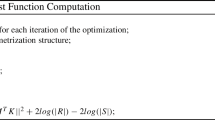Abstract
The identification of non-parametric impulse response functions (IRFs) from noisy finite-length data records is analysed using the techniques of matrix perturbation theory. Based on these findings, a method for IRF estimation is developed that is more robust than existing techniques, particularly when the input is non-white. Furthermore, methods are developed for computing confidence bounds on the resulting IRF estimates. Monte Carlo simulations are used to assess the capabilities of this new method and to demonstrate its superiority over classical techniques. An application to the identification of dynamic ankle stiffness in humans is presented.
Similar content being viewed by others
References
Bardakjian, B., Wright, W., Valiante, T., andCarlen, P. (1994): ‘Nonlinear system identification of hippocampal neurons’,in Marmarelis, V. (Ed.): ‘Advanced methods of physiological system modeling’ (Plenum Press, New York) Vol. 3, pp. 179–194
Bendat, J., andPiersol, A. (1986): ‘Random data analysis, and measurement procedures’, (John Wiley & Sons, New York) 2nd edn.
Berthier, N., Barto, A., andMoore, J. (1991): ‘Linear systems analysis of the relationship between firing of deep cerebellar neurons and the classically conditioned nictitating membrane response in rabbits’,Biol. Cybern.,65, 99–105
Boyd, S., andChua, L. (1985): ‘Fading memory and the problem of approximating nonlinear operators with Volterra series’,IEEE Trans.,CAS-32 (11), pp. 1150–1161
Doukoglou, T., Hunter, I., andKearney, R. (1993): ‘Nonparametric two-dimensional point spread function estimation for biomedical imaging’,Med. Biol. Eng. Comput.,31, (3), pp. 277–283
Golub, G., andVan Loan, C. (1989): ‘Matrix computations’ (The John Hopkins University Press, Baltimore) 2nd edn.
Hunter, I. (1985): ‘Nonlinearities in isolated frog muscle fiber mechanical dynamics’,Soc. Neurosci. Abstr.,11, p. 406
Hunter, I., andKearney, R. (1983): ‘Two-sided linear filter identification’,Med. Biol. Eng. Comput. 21, pp. 203–209
Hunter, I., andKorenberg, M. (1986): ‘The identification of nonlinear biological systems: Wiener and Hammerstein cascade models’,Biol. Cybern. 55, pp. 135–144.
Kearney, R., andHunter, I. (1990): ‘System identification of human joint dynamics’,CRC Crit. Rev. Biomed. Eng.,18, pp. 55–87
Kearney, R., Hunter, I., Weiss, P., andSpring, K. (1983): ‘Tilttable/ankle-actuator system for the study of vestibulospinal reflexes’,Med. Biol. Eng. Comput.,21, pp. 301–305
Korenberg, M. (1991): ‘Parallel cascade identification and kernel estimation for nonlinear systems’,Ann. Biomed. Eng. 19, pp. 429–455
Korenberg, M., andHunter, I. (1986): ‘The identification of nonlinear biological systems: LNL cascade models’,Biol. Cybern.,55, pp. 125–134
Ljung, L. (1987): ‘System identification theory for the user’, (Prentice Hall Inc., Englewood Cliffs, New Jersey)
MacNeil, J. (1990): ‘Identification of time-varying human joint dynamics’, MSc Thesis, McGill University, Departments of Mechanical Engineering and Biomedical Engineering
Marmarelis, V., Chon, K., Chen, Y., Marsh, D., andHolstein-Rathlou, N. (1993): ‘Nonlinear analysis of renal autoregulation under broadband forcing conditions’,Ann. Biomed. Eng.,21 (6), pp. 591–603
Marple, S. (1981): ‘Efficient least squares FIR system identification’,IEEE Trans.,ASSP-29 (1), pp. 62–73
Morier, R., Weiss, P., andKearney, R. (1990): ‘Low inertia, rigid limb fixation using glass fibre casting bandage’,Med. Biol. Eng. Comput.,8, pp. 96–99
Porat, B., andKailath, T. (1983): ‘Normalized lattice algorithms for least-squares FIR system identification’,IEEE Trans.,ASSP-31 (1), pp. 122–128
Rabiner, L., Crochiere, R., andAllen, J. (1978): ‘FIR system modeling and identification in the presence of noise and with bandlimited inputs’,IEEE Trans.,ASSP-26 (4), pp. 319–333
Stewart, G. (1990): ‘Stochastic perturbation theory’,SIAM Rev.,32, (4), pp. 579–610
Trainor, J. (1994): ‘Identification of time-varying human joint dynamics during an electrically stimulated twitch. MSc Thesis, McGill University, Departments of Mechanical Engineering and Biomedical Engineering.
Tummala, M. (1990): ‘Efficient iterative methods for FIR least squares identification’,IEEE Trans.,ASSP-38 (5), pp. 887–890
Weiss, P., Hunter, I., andKearney, R. (1988): ‘Human ankle joint stiffness over the full range of muscle activation levels’,J. Biomech.,21, pp. 539–544
Westwick, D., andKearney, R. (1994): ‘Identification of multiple-input nonlinear systems using non-white test signals’in Marmarelis, V. (Ed.): ‘Advanced methods of physiological system modeling’ (Plenum Press, New York) Vol. 3, pp. 163–178
Author information
Authors and Affiliations
Rights and permissions
About this article
Cite this article
Westwick, D.T., Kearney, R.E. Identification of physiological systems: a robust method for non-parametric impulse response estimation. Med. Biol. Eng. Comput. 35, 83–90 (1997). https://doi.org/10.1007/BF02534135
Received:
Accepted:
Issue Date:
DOI: https://doi.org/10.1007/BF02534135




